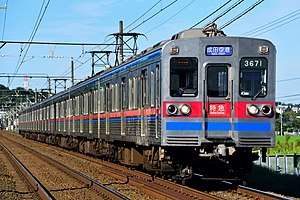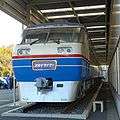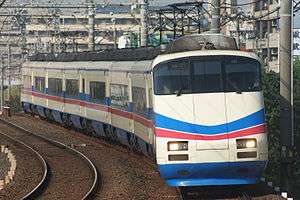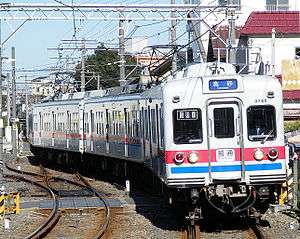Keisei Electric Railway
The Keisei Electric Railway Company, Ltd.[2] (stylized as K'SEI since 2001) is a major private railway in Chiba Prefecture and Tokyo, Japan. The name Keisei is the combination of the kanji 京 from Tokyo (東京, Tōkyō) and 成 from Narita (成田, Narita), which the railway's main line connects. The combination uses different readings than the ones used in the city names. The railway's main line runs from Tokyo to Narita and the eastern suburb cities of Funabashi, Narashino, Yachiyo, and Sakura. Keisei runs an airport limited express train called the Skyliner from Ueno and Nippori to Narita International Airport.
 | |
Native name | 京成電鉄株式会社 |
|---|---|
Romanized name | Keisei Dentetsu kabushiki gaisha |
| Public KK | |
| Traded as | TYO: 9009 Nikkei 225 component |
| ISIN | JP3278600006 |
| Industry | Private railroad |
| Founded | 30 June 1909 |
| Headquarters | Yawata, Ichikawa, Chiba, Japan |
Key people | Tsutomu Hanada (President) |
| Owners | Nippon Life (3.50%) The Oriental Land Company (3.41 cross shareholding) Mizuho Bank (3.33%) |
Number of employees | 1,728 (2019)[1] |
| Subsidiaries | Keisei Bus Shin-Keisei Electric Railway Hokuso Railway |
| Website | www |

In addition to its railway business, the Keisei Electric Railway Company owns large bus and taxi services and some real estate holdings. It owns a large share of the Oriental Land Company which owns and manages the Tokyo Disney Resort. Keisei is listed on the Tokyo Stock Exchange and is a constituent of the Nikkei 225 index.[3]
History
Keisei was founded on June 30, 1909 and began services on November 3, 1912, initially operating local train service in eastern Tokyo. Its main line reached Narita in 1930 and Ueno in 1933.[4]
Originally a narrow gauge (1,372 mm or 4 ft 6 in Scotch gauge) operator, Keisei converted to 1,435 mm (4 ft 8 1⁄2 in) standard gauge in 1959. In 1960, Keisei began through service with the Toei Asakusa Line, the first interline through service arrangement in Japan.[4]
Skyliner service began in 1973 and started serving the airport in 1978, when the first Narita Airport Station opened (today's Higashi-Narita station). A new underground station was opened in 1991 to provide a more direct connection to terminal 1, and in 1992 service began to terminal 2.[4] On July 17, 2010, Skyliner switched its route to the newly built Narita Sky Access and reduced the travel time by 15 minutes.
Lines
Keisei operates 152.8 km of railway which consists of one trunk line named the Main Line and six branchlines.[1]
| Line name | Japanese | Endpoints | Distance (km) |
Type1 |
|---|---|---|---|---|
| Main Line | 本線 | Keisei-Ueno – Komaino Junction | 67.2 | 1 |
| Komaino Junction – Narita Airport Terminal 1 | 2.1 | 2 | ||
| Oshiage Line | 押上線 | Oshiage – Aoto | 5.7 | 1 |
| Chiba Line | 千葉線 | Keisei-Tsudanuma – Chiba Chūō | 12.9 | 1 |
| Chihara Line | 千原線 | Chiba Chūō – Chiharadai | 10.9 | 1 |
| Higashi-Narita Line | 東成田線 | Keisei-Narita – Higashi-Narita | 7.1 | 1 |
| Kanamachi Line | 金町線 | Keisei-Takasago – Keisei-Kanamachi | 2.5 | 1 |
| Narita Airport Line (Narita Sky Access) |
成田空港線 | Keisei-Takasago – Narita Airport Terminal 1 | 51.4 | 2 |
| Overlap | Keisei-Narita – Komaino Junction2 | (6.0) | 1 | |
| Narita Airport Terminal 2·3 – Narita Airport Terminal 13 | (1.0) | 2 | ||
| Total | 152.8 | |||
| Projected lines | ||||
| (Chihara Line extension) | Chiharadai – Amaariki | 8.2 | 1 | |
Legend
- "Type" indicates the type of railway business under the Railway Business Act of Japan. Type 1 operator owns and operates the railway while Type 2 operator operates but does not owns the railway.
- This section is shared by the Main Line and the Higashi-Narita Line.
- This section is shared by the Main Line and the Narita Airport Line.
Subsidiaries
Keisei Group includes:
- Shin-Keisei Electric Railway (Shin-Keisei Line)
- Chiba New Town Railway
- Hokusō Railway (Hokusō Line)
- Kantō Railway
- Kashima Railway Company (Kashima Railway Line, closed in 2007)
- Kominato Railway (Kominato Line)
- Maihama Resort Line (Disney Resort Line)
- Narita Airport Rapid Railway (Owner of a part of Narita Sky Access tracks)
- Nokogiriyama Ropeway
- The Oriental Land Company
- Tsukuba Kankō Railway (Mt. Tsukuba Cable Car and Mt. Tsukuba Ropeway)
Companies related to Keisei, although not a group member:
- Shibayama Railway
- Tōyō Rapid Railway (Tōyō Rapid Railway Line)
Rolling stock
Commuter
- 3000 series (since 2003)[5]
- 3050 series (since 2010)[5]
- 3100 series (since 2019)[5]
- 3400 series (since 1993)[5]
- 3500 series (since 1972)[5]
- 3600 series (since 1982)[5]
- 3700 series (since 1991)[5]
 3000 series
3000 series 3050 series
3050 series 3400 series
3400 series 3500 series
3500 series 3600 series
3600 series 3700 series
3700 series
Former
Limited express
- 1500 series (1941–1987)
- 1600 series (1953–1981)
- AE series (1973–1993)
- AE100 series (1990–2016)
 AE series
AE series AE100 series
AE100 series
Commuter
- 1 series (1912-1927)
- 20 series (1921-1971)
- 33/39/45 series (1923-1978)
- 300 series (1955-1982)
- 100/126 series (1926-1987)
- 200/210/220/500/510 series (1931-1990)
- 210/2000/2100 series (1932-1985)
- 700/2200 series (1954-1982)
- 750/2250 series (1954-1973)
- 1100 series (1941-1987)
- 1500 series (1941-1987)
- 2000 series (1948-1990)
- 3000 series (1958-1991)
- 3050 series (1959-1995)
- 3100 series (1960-1998)
- 3150 series (1963-2001)
- 3200 series (1964-2007)
- 3300 series (1968-2015)
- 3200 series
 3300 series
3300 series
See also
- Hokuso Railway
- Tokyo Disneyland
- Skyliner
References
- "KEISEI Group | IR/Corporate Information". KEISEI Group. Retrieved 2020-03-17.
- 京成電鉄株式会社 Keisei Dentetsu Kabushiki-gaisha
- "Components - Nikkei Indexes". Retrieved 17 Mar 2020.
- "KEISEI Group | IR/Corporate Information". KEISEI Group. Retrieved 2020-03-17.
- "Keisei". All About Japanese Trains. Retrieved 2020-03-17.
External links
| Wikimedia Commons has media related to Keisei Electric Railway. |
- Official site (in Japanese)
- English part of official site (in English)